The riddle as old as time, what came first the egg or the chicken, is puzzling the heads of philosophers, scientists, and business owners alike. Despite what science says about it, this problem must be solved differently in the business world.
The chicken and egg problem started from mutual dependency between two elements. Simply put, it means that both sellers and buyers require the presence of the other. So, in this article, we will unravel strategic angles to navigate this challenge.
Join us, as we unravel the mysteries of the chicken and egg situation and search for the means to solve this problem.
What is the Chicken and Egg Problem?
Generally speaking, the chicken and egg problem refers to the challenge of building a two-sided market, where the presence and activity of one group (like sellers or service providers) is necessary to attract another group (like buyers or service users), and vice versa.
For instance, a new online marketplace needs enough sellers to offer a variety of products or services to attract buyers. However, sellers are more likely to join and remain active in a marketplace if there are already many potential buyers. This interdependence creates a dilemma for the marketplace’s initial growth, as it needs to simultaneously attract both categories of customers to become successful.
This philosophical question might apply to many sides of our lives, but in business, and marketplaces specifically, it can cost you profits.
The Chicken and Egg Problem in Online Marketplaces
So, how does the chicken and egg problem manifest itself in the marketplace businesses? It all starts with mutual dependence. Attracting both types of customers–sellers and buyers–isn’t easy in the first stages of marketplace business development, and can fold your startup.
Without a sufficient number of sellers offering diverse products or services, buyers won’t create the demand. On the flip side, sellers may be cautious about joining a marketplace with a small or inactive user base. The challenge will interfere with the generation of a critical mass of both your audiences, which is crucial for the marketplace’s success.
90% of all startups fail, 10% in the first year, and 70% throughout the second. And just 1% of them will become a unicorn. Many of the unicorns, such as Etsy gracefully battled the chicken and egg situation. So, we believe if you can do the same, you will be one step closer to success.
Strategies to Overcome the Chicken and Egg Problem
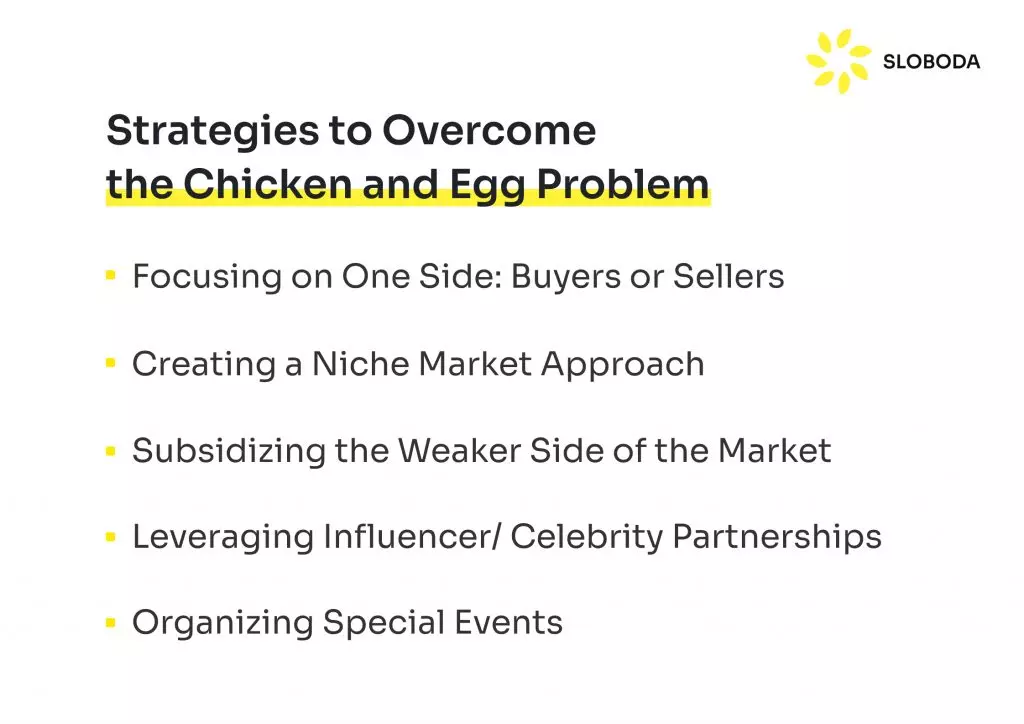

Strategies to Overcome the Challenge
The chicken and egg situation requires innovative and practical tactics to break the cycle of interdependence.
Deploying thoughtful approaches aimed at creating a self-sustaining ecosystem is essential to ensure the balance. So, let’s delve into key strategies that have proven effective in overcoming the chicken and egg problem.
Validate your strategy with Sloboda
Contact us
Focusing on One Side: Buyers or Sellers
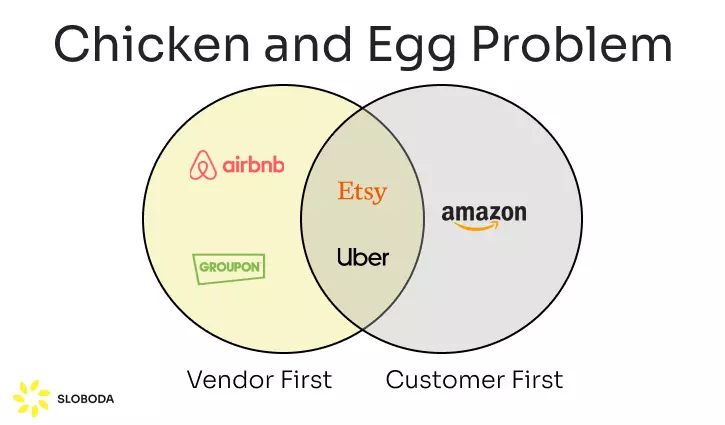

Chicken and Egg Problem
Focusing on one side allows business owners to improve resource distribution and demand, and generally improve their business focus. Moreover, it enables the marketplace to refine and optimize its operations based on the dynamics of the initially targeted customers. Overall, you can turn to this strategy if you seek quicker wins, as achieving critical mass on one side rapidly facilitates the organic growth of the other.
To impose your focus on sellers, try to prioritize their acquisition and satisfaction. This way, you can make sure that sellers have access to a receptive and active consumer audience. Show increased demand and visibility to the sellers, and naturally more buyers will be attracted to your platform.
In turn, to make the customers the focal point, we advise dedicating resources to amassing diverse items in stock. Whether the buyers want a service or a product, you should facilitate the customer-centric approach. By curating a compelling array of offerings, you will have more means to attract and retain a critical mass of consumers and as the buyer base expands, the customers will be drawn to the platform, too.
Despite everything that was said, there is always the risk of imbalance. As an example, if a new platform attracts many buyers but has a limited selection of products (or vice versa), this demand imbalance will result in dissatisfaction. It was used by one of our clients, Foody. They are a recipe-based marketplace and first, they decided to attract chefs, hoping they would engage the buyers. The other client of ours also uses this strategy for a marketplace, focusing first on the suppliers. This strategy is one of the most popular and many of our clients turn to it to attract the desired core of their target audience.
Creating a Niche Market Approach
If you focus on a unique market segment, it would create a new niche for your business specifically. A niche market approach involves tailoring the platform to the specific needs and preferences of a focused user base, fostering engagement and loyalty within that niche. Here is how it is done step by step:
- Identifying the niche. It could be based on geographic location, product category, demographics, or specific interests within a broader market.
- Customizing the experience. Develop specialized features, and unique content, or curate a selection of products or services that resonate with the targeted audience.
- Building a community. Your marketing efforts are directed toward the identified niche to reach potential users who are more likely to find value in the specialized offerings.
Operating in a niche market reduces direct competition, allowing the platform to establish itself as a go-to destination for specific needs. Satisfied users within the niche are more likely to share their positive experiences, leading to organic growth. However, while a niche market can be lucrative, it may have a natural ceiling in terms of growth potential. The success of this strategy hinges on the viability and sustainability of the chosen niche.
One of our customers had a similar approach. Being a listing marketplace for booking offices, their new unique niche allowed them to carve this segment of the market and remain partially unphased by competitiveness.
Subsidizing the Weaker Side of the Market
Subsidizing the weaker market side is used as a strategic intervention aimed at rebalancing the scales of the chicken and egg problem. In this approach, the platform provides incentives, financial support, or special privileges to the underrepresented user group—whether buyers or sellers—to stimulate their participation. As a result, this kickstarts the activity and demand on the platform.
We advise utilizing this strategy to acknowledge the initial imbalance and create a more equitable environment.
For buyers, you could offer discounts, exclusive deals, and loyalty programs to encourage users to explore the platform. Sellers would be interested in reduced fees, and promotional support to stimulate them to list their products or services on the marketplace. However, subsidizing one side of the market can be resource-intensive, requiring a financial commitment from the platform.
There may be concerns about the long-term longevity of this method. Once incentives are removed, it is a good practice to ensure your platform is self-sustaining.
Leveraging Influencer and Celebrity Partnerships
By collaborating with leaders of thought who have a significant following and hold influence over your target audience, a platform can rapidly elevate its visibility.
You can achieve a higher level of trust and user engagement when cooperating with an influencer targeting your audience. This attracts both buyers and sellers and cultivates a sense of trust and excitement around the marketplace.
- Identifying relevant celebrities. Include individuals with a strong presence in the industry or lifestyle fit for your business clients.
- Starting marketing campaigns. Buy sponsored content, and product endorsements, or start exclusive partnerships that highlight the unique offerings.
- Starting social media takeovers. For example, live sessions, product showcases, or behind-the-scenes glimpses, fostering a more engaging experience.
- Offering exclusive deals. This encourages the followers of your chosen influencers to participate but also provides an added benefit for early adopters.
Influencers and celebrities bring a broad and engaged audience, exponentially increasing the marketplace’s reach and exposure. Endorsements from trusted figures enhance the platform’s credibility and build trust among potential users. However collaborating with influencers and celebrities may involve significant costs, depending on their popularity and reach. Balancing the investment with expected returns is crucial.
One of our customers, Foody, started with a similar strategy. As a recipe marketplace, they’ve turned to celebrity cooks to bring recognition and demand to their products.
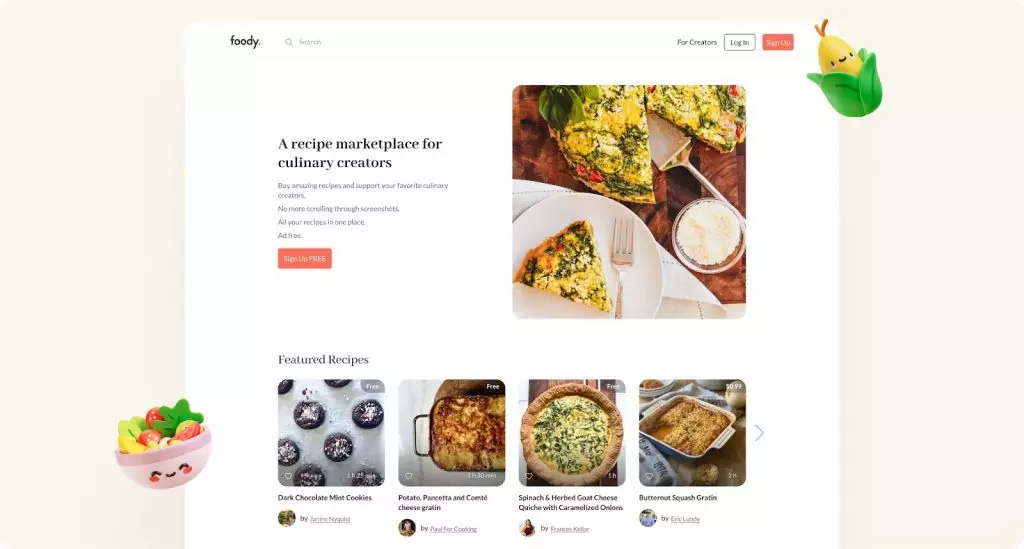

Foody
After the official release, the Foody platform increased its new functionality by 1.5 times. Before the product release, Foody raised $1.5M in the pre-seed round in November 2021.
Organize Special Events and Engaging Community
This strategy can help you tackle the chicken and egg problem by creating a dynamic and interactive environment. Organizing events and community will attract both buyers and sellers and also cultivate a sense of belonging and excitement. It also generates excitement and discussions within the community, creating a buzz that attracts new users and retains existing ones.
Special events can range from promotions and contests to themed gatherings, creating memorable experiences that encourage sustained participation and growth.
On the other hand, ensuring a diverse range of events is essential to appeal to a broad audience. One-size-fits-all approaches may only resonate with some. The impact of special events on user acquisition and retention requires effective analytics to gauge success and make informed adjustments. Additionally, events are costly options that might not be suitable for startups at the initial stages.
Global Strategies for Marketplaces
Crafting effective global tactics is a necessity in an era where the boundaries of commerce are increasingly blurred. This exploration delves into the global marketplace strategies, unveiling insights and approaches that empower platforms to successfully navigate the international markets.
So, let’s take a look at examples of global marketplace success as we review the path for platforms aspiring to thrive on the global stage.
“Single Player Mode” (Standalone Mode) Strategy
Single Player Mode entails selling to one side of the marketplace, focusing on a tool or solution that solves a problem for the supply side. The concept of “Single Player Mode” is a strategic approach aimed at overcoming initial challenges by focusing on the company’s growth. The strategy entails that the marketplace is developing the client base and functionality without collaborating or getting in direct competition with other marketplaces. Coined by Chris Dixon, the term was further discussed by Sangeet Paul Choudary as a Standalone Mode.
Its main aim is to achieve initial critical mass and create long-term value for users and defensibility for the company. This approach reduces complexity and cost by avoiding simultaneous efforts to attract both buyers and sellers. On the downside of it, this strategy makes it more difficult to keep up with the market. In our opinion, it would only work best for the initial stages of your startup, but eventually marketing efforts will be paramount.
A notable example is OpenTable, an online restaurant reservation service. It started as a software tool for restaurants to manage reservations, addressing a critical need on the supply side. Once they achieved a critical mass of vendors, OpenTable seamlessly expanded to the demand side, attracting diners without significant marketing expenses.
“Fill Empty Seats” Strategy
The “Fill Empty Seats” strategy is a go-to-market approach that involves actively seeking to connect buyers with available supplies or services. Unlike the “Single Player Mode” strategy, which focuses on initially adding value to one side of the marketplace, the “Fill Empty Seats” strategy aims to facilitate immediate interactions and transactions between buyers and sellers.
Key characteristics of the “Fill Empty Seats” strategy include:
- Simultaneous onboarding: the strategy involves the simultaneous onboarding of both buyers and sellers to the marketplace.
- Marketing to both sides: the marketplace actively promotes and markets its platform to both potential buyers and sellers using more resource-intensive marketing efforts.
- Addressing dual value propositions: the platform delivers the value propositions for both buyers and sellers from the outset. This creates a balanced and appealing experience for both sides.
- Immediate transaction focus: the emphasis is on facilitating transactions and interactions between buyers and sellers as quickly as possible. This creates a vibrant and active marketplace from the early stages.
- Increased complexity and cost: the strategy involves managing the dynamics and expectations of both user groups simultaneously. This inevitably sums up to higher cost and complexity.
A prominent example of the fill-empty-seats strategy is the ride-sharing platform Uber. To tackle this chicken-and-egg problem, Uber started to focus on recruiting drivers first, addressing the need for available transportation options. The downsides of this strategy might produce imbalance if not executed properly. It focuses on both aspects and can seem risky as if one part of it fails, it fails as a whole.
Developing a Marketplace Where Users Play Multiple Roles
Developing a marketplace where users can play multiple roles is a strategic solution to the perennial chicken-and-egg problem as well. It works by allowing users to engage in various roles simultaneously, such as buyers, sellers, influencers, and moderators. This way, the platform can create a dynamic and self-sustaining ecosystem.
The key lies in designing a user-friendly onboarding process that seamlessly facilitates users switching between roles. You must also think through the creation of role-specific dashboards that will cater to the unique needs of each participant. Implementing cross-role incentives and integrated communication channels encourages users to actively participate in multiple capacities. Dual-focused marketing campaigns should highlight the benefits of playing various roles. Emphasize the value each role contributes to the overall marketplace experience.
For example, community-building initiatives, such as forums and events, foster a sense of belonging and encourage diverse participation. Educational resources and feedback mechanisms further guide users and build trust. The only downside of it is the extensive budget. This strategy might work better for those startups that already have an active audience and financing.
Airbnb is an example of developing a marketplace where users can play multiple roles. The platform revolutionized the hospitality industry by creating a platform that enables users to seamlessly switch between being hosts and guests, fostering a dynamic and interconnected ecosystem. Airbnb case is the classic of iterative development and continuous user feedback. The case shows that with the strategy, the marketplace can optimize features, address pain points, and ultimately break the cycle of the chicken and egg problem, creating a vibrant and interconnected community.
Chicken and Egg Problem and Major Platforms that Overcame Initial Hurdles
The chicken and egg problem is a classic challenge for emerging platforms. As we established previously, it involves the difficulty of attracting both buyers and sellers simultaneously. However, successful marketplaces like Etsy, Groupon, and others have navigated these initial hurdles with innovative strategies.
Etsy
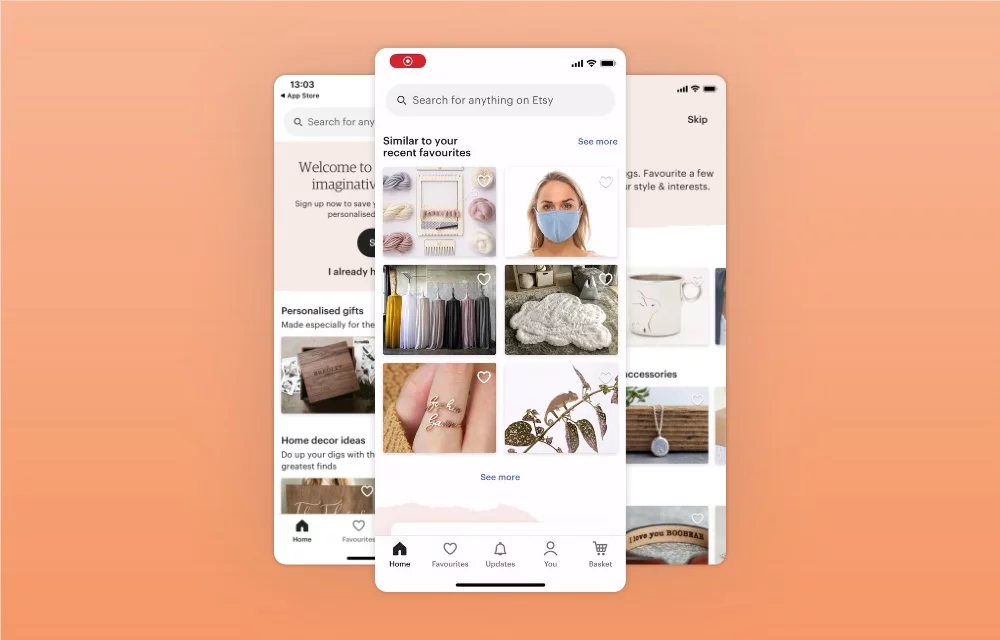

Etsy
In our opinion, Etsy, the artisanal marketplace, initially focused on a “Single Player Mode” strategy. Recognizing the challenge of attracting buyers without a critical mass of sellers, Etsy concentrated on appealing to sellers first. By providing a user-friendly platform and tools for sellers to showcase their handmade goods, Etsy created value for the supply side. Once a substantial number of sellers were onboard, the marketplace naturally attracted buyers seeking unique and handcrafted supplies, effectively breaking the chicken and egg cycle.
Groupon
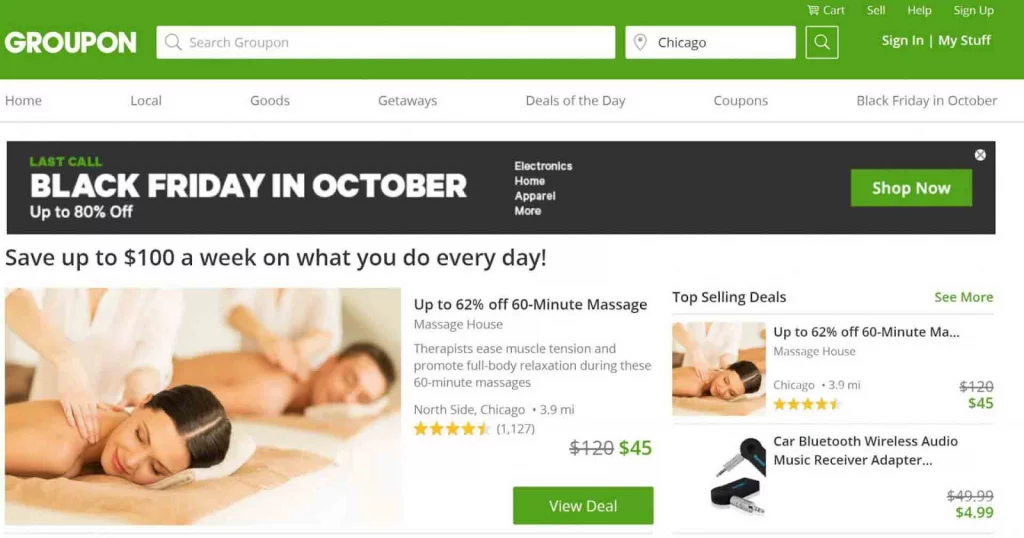

Groupon
Groupon, the deals and discounts platform, utilized a local-centric approach to overcome the initial hurdles. Focusing on a single city initially, Groupon concentrated on acquiring local businesses as sellers. This created a concentrated and attractive offering for buyers interested in local deals. As Groupon gained popularity among local businesses and consumers, it expanded its reach to additional cities, leveraging the critical mass built in the initial location.
Uber
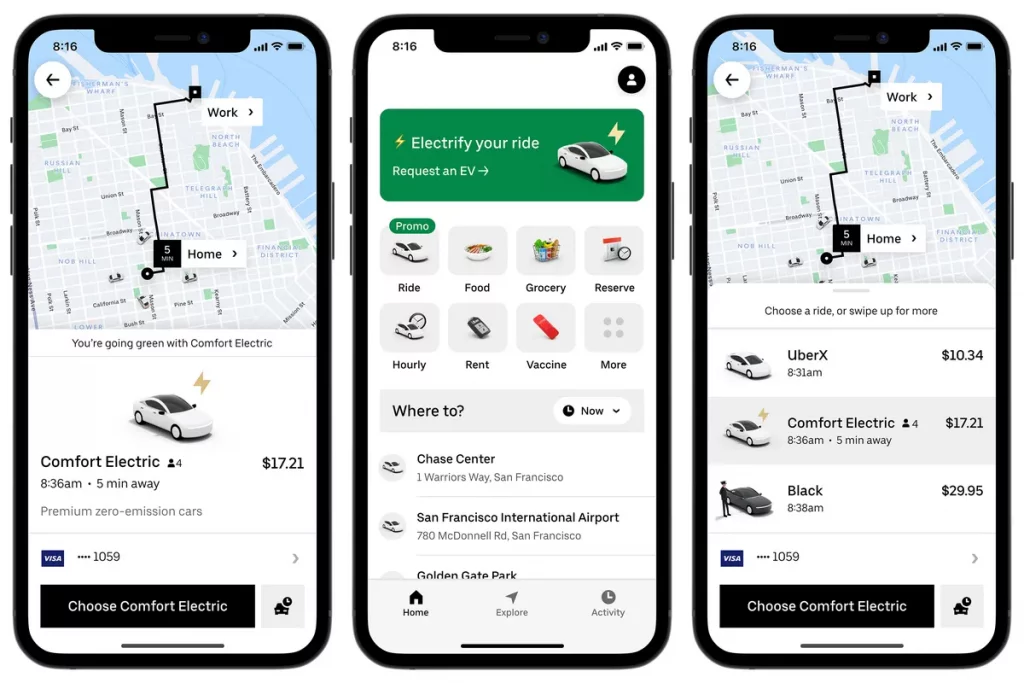

Uber
Uber, the ride-sharing giant, deployed a strategic “Fill Empty Seats” approach. Understanding the challenge of attracting both riders and drivers simultaneously, Uber concentrated on recruiting drivers first. By offering incentives and competitive earnings, Uber enticed drivers to join the platform, ensuring a sufficient supply of vehicles. Once a reliable network of drivers was established, Uber turned its attention to attracting riders, benefiting from the existing pool of available transportation options.
In essence, these major platforms employed a variety of tactics to address the chicken and egg problem. These examples showcase the importance of tailored strategies to overcome the specific hurdles faced by different marketplaces during their early stages.
Conclusion and Key Takeaways
Despite the chicken and egg problem being a significant challenge for marketplaces in the initial stage of their growth, we believe that it is still possible to leverage it. With the right approaches and tactics, you can do what multiple companies have done before you – create something unique that tailors to your audience exclusively.
The strategies we’ve most encountered in our practice are focusing on one side (buyers or sellers), creating a niche market, and leveraging influencers and celebrity partnerships. These tactics have been used by our clients, which allowed them to receive better results in financing and grow their customer base.
Find the right approach for your business and focus your efforts on achieving it. Hopefully, this will help you claw your way up to the 1% of unicorn startups. To help understand the right strategy for you, contact the Sloboda Studio team.